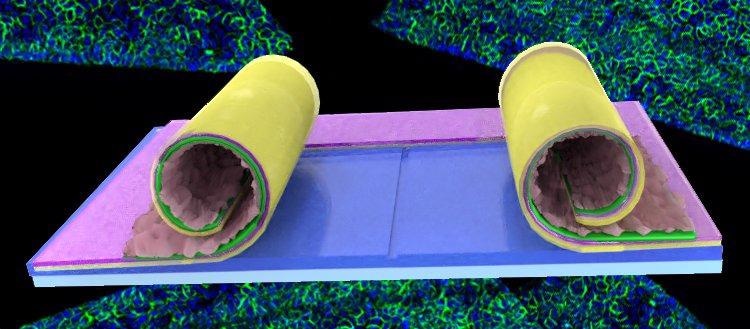How do human cells organize themselves to give the organs their ultimate shape? The solution is morphogenesis, a collection of systems that controls their spatial distribution throughout embryonic development. In this sector, a team from the University of Geneva (UNIGE) recently discovered an unexpected discovery: when a tissue curves, the volume of the cells that makes it up grows rather than decreases.
 “Sheet” of curved cells in the form of a tube: the cells initially organized flat were forced to curl. Image Credit: Aurélien Roux.
“Sheet” of curved cells in the form of a tube: the cells initially organized flat were forced to curl. Image Credit: Aurélien Roux.
This breakthrough brings up new possibilities for in vitro organ cultivation, a partial replacement for animal testing. It also raises new possibilities for the manufacture of certain materials. The findings of this study were reported in the journal Developmental Cell.
Morphogenesis refers to the processes that determine the distribution of cells in space to create the form and structure of the tissues and organs. These processes operate throughout embryonic development and explain how the folds of human intestines and the alveoli of the lungs are produced, for example. In other words, these occurrences are fundamental to human and all living organisms’ evolution.
Cells swell and this is unexpected
Professor Roux’s team explored how the cells that make up a tissue react and adapt when it is twisted a recent research. The UNIGE scientists discovered an unexpected finding when rolling a monolayer of cells in vitro, which is a compact, flat assembly of cells stacked next to each other. This is the exact opposite of what happens when users bend an elastic material.
We found that the volume of cells located in the curvature increased by about 50% after five minutes instead of decreasing, and then returned to normal within 30 minutes.”
Aurélien Roux, Study Last Author and Professor, Department of Biochemistry, University of Geneva
The researchers found that by stretching this “sheet” of cells, which is comparable to the one that makes up human skin, the latter inflated to adopt the shape of miniature domes.
The fact that this increase in volume is staggered in time and transient also shows that it is an active and living system.”
Caterina Tomba, Study First Author and Former Researcher, Department of Biochemistry, University of Geneva
A mechanical and biological phenomenon
This rise in volume is explained by a combination of two occurrences. “The first is a mechanical reaction to the curvature, the second is linked to the osmotic pressure exerted on the cell,” adds Roux.
The cells develop in a saltwater environment. Water can flow through the semi-permeable membrane that divides them from its surroundings, but salt cannot, putting pressure on the cell. The higher the salt concentration outside—and hence the osmotic pressure—the more water passes through the cell’s membrane, increasing its volume.
“When a curvature is induced, the cells react as if it were the osmotic pressure that was increasing. They therefore absorb more water, which has the effect of making them swell,” states the researcher.
Useful for reducing animal experimentation
Understanding how cells react to bending is a significant step forward in the production of organoids in vitro. These three-dimensional multicellular constructs, which are meant to imitate the micro-anatomy of an organ and its functions, can certainly enable extensive study without the use of animals.
“Our discovery is an active phenomenon to be taken into account in order to control the spontaneous growth of organoids, i.e. to obtain the desired shape and size of the organ,” notes Roux. The long-term objective is to be able to “grow” any organ replacement for specific patients.
The industry is also interested in these findings.
Today, there are no materials that increase in volume when folded. Engineers have conceptualized such a material without ever realizing it, because its production was extremely complicated. Our work therefore also offers new keys to understanding the development of such materials.”
Aurélien Roux, Study Last Author and Professor, Department of Biochemistry, University of Geneva
Source:
Journal reference:
Tomba, C., et al. (2022) Epithelial cells adapt to curvature induction via transient active osmotic swelling. Developmental Cell. doi.org/10.1016/j.devcel.2022.04.017.